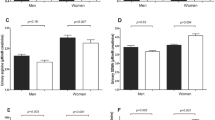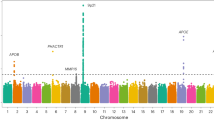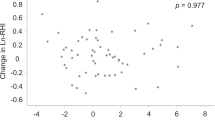Abstract
Single nucleotide polymorphisms (SNPs) in the endothelial nitric oxide synthase (NOS3) gene have been related to endothelium-dependent vasodilation in either conduit or resistance arteries with divergent results. In the Prospective Study of the Vasculature in Uppsala Seniors study, 959 participants aged 70 (51% men) were evaluated with brachial artery ultrasound to assess flow-mediated vasodilation (FMD; reflecting conduit arteries) and invasive forearm technique with intrabrachial infusion of acetylcholine (endothelium-dependent vasodilation (EDV); reflecting resistance arteries). The 23 SNPs analysed by minisequencing captured >90% of the common genetic variation in the NOS3 gene, using the HapMap population of European ancestry (CEU) as reference. One SNP (Glu298Asp) was related to FMD (nominal P=0.0018), but not to EDV (nominal P=0.76) after adjustment for sex, systolic blood pressure, diastolic blood pressure, pulse rate, antihypertensive treatment, total cholesterol, high-density cholesterol, lipid-lowering medication, fasting glucose, antidiabetic medication, body mass index, current smoking and prior diagnosis of cardiovascular disease. This relation was significant in both men and women in sex-specific analyses, and remained significant after adjusting for multiple testing (empirical P=0.029 from bootstrap resampling). None of the constructed haplotypes were related to vasodilation. The Glu298Asp SNP in the NOS3 gene was related to endothelium-dependent vasodilation in conduit, but not in resistance arteries. This SNP has previously been related to coronary heart disease, and our findings should stimulate to replication and exploration of the association of NOS3 variation with endothelial function in other settings.
This is a preview of subscription content, access via your institution
Access options
Subscribe to this journal
Receive 12 digital issues and online access to articles
$119.00 per year
only $9.92 per issue
Buy this article
- Purchase on Springer Link
- Instant access to full article PDF
Prices may be subject to local taxes which are calculated during checkout

Similar content being viewed by others
References
Furchgott RF, Zawadzki JV . The obligatory role of endothelial cells in the relaxation of arterial smooth muscle by acetylcholine. Nature 1980; 288: 373–376.
Palmer RM, Ashton DS, Moncada S . Vascular endothelial cells synthesize nitric oxide from L-arginine. Nature 1988; 333: 664–666.
Celermajer DS, Sorensen KE, Bull C, Robinson J, Deanfield JE . Endothelium-dependent dilation in the systemic arteries of asymptomatic subjects relates to coronary risk factors and their interaction. J Am Coll Cardiol 1994; 24: 1468–1474.
Corretti MC, Anderson TJ, Benjamin EJ, Celermajer D, Charbonneau F, Creager MA et al. Guidelines for the ultrasound assessment of endothelial-dependent flow-mediated vasodilation of the brachial artery: a report of the International Brachial Artery Reactivity Task Force. J Am Coll Cardiol 2002; 39: 257–265.
Linder L, Kiowski W, Buhler FR, Luscher TF . Indirect evidence for release of endothelium-derived relaxing factor in human forearm circulation in vivo. Blunted response in essential hypertension. Circulation 1990; 81: 1762–1767.
Creager MA, Cooke JP, Mendelsohn ME, Gallagher SJ, Coleman SM, Loscalzo J et al. Impaired vasodilation of forearm resistance vessels in hypercholesterolemic humans. J Clin Invest 1990; 86: 228–234.
Perticone F, Ceravolo R, Pujia A, Ventura G, Iacopino S, Scozzafava A et al. Prognostic significance of endothelial dysfunction in hypertensive patients. Circulation 2001; 104: 191–196.
Gokce N, Keaney Jr JF, Hunter LM, Watkins MT, Menzoian JO, Vita JA . Risk stratification for postoperative cardiovascular events via noninvasive assessment of endothelial function: a prospective study. Circulation 2002; 105: 1567–1572.
Lind L, Hall J, Johansson K . Evaluation of four different methods to measure endothelium-dependent vasodilation in the human peripheral circulation. Clin Sci (Lond) 2002; 102: 561–567.
Lind L, Fors N, Hall J, Marttala K, Stenborg A . A comparison of three different methods to evaluate endothelium-dependent vasodilation in the elderly: the Prospective Investigation of the Vasculature in Uppsala Seniors (PIVUS) study. Arterioscler Thromb Vasc Biol 2005; 25: 2368–2375.
Komatsu M, Kawagishi T, Emoto M, Shoji T, Yamada A, Sato K et al. ecNOS gene polymorphism is associated with endothelium-dependent vasodilation in Type 2 diabetes. Am J Physiol Heart Circ Physiol 2002; 283: H557–H561.
Leeson CP, Hingorani AD, Mullen MJ, Jeerooburkhan N, Kattenhorn M, Cole TJ et al. Glu298Asp endothelial nitric oxide synthase gene polymorphism interacts with environmental and dietary factors to influence endothelial function. Circ Res 2002; 90: 1153–1158.
Li R, Lyn D, Lapu-Bula R, Oduwole A, Igho-Pemu P, Lankford B et al. Relation of endothelial nitric oxide synthase gene to plasma nitric oxide level, endothelial function, and blood pressure in African Americans. Am J Hypertens 2004; 17: 560–567.
Rossi GP, Taddei S, Virdis A, Cavallin M, Ghiadoni L, Favilla S et al. The T-786C and Glu298Asp polymorphisms of the endothelial nitric oxide gene affect the forearm blood flow responses of Caucasian hypertensive patients. J Am Coll Cardiol 2003; 41: 938–945.
Naber CK, Baumgart D, Altmann C, Siffert W, Erbel R, Heusch G . eNOS 894T allele and coronary blood flow at rest and during adenosine-induced hyperemia. Am J Physiol Heart Circ Physiol 2001; 281: H1908–H1912.
Paradossi U, Ciofini E, Clerico A, Botto N, Biagini A, Colombo MG . Endothelial function and carotid intima-media thickness in young healthy subjects among endothelial nitric oxide synthase Glu298-->Asp and T-786-->C polymorphisms. Stroke 2004; 35: 1305–1309.
Kathiresan S, Larson MG, Vasan RS, Guo CY, Vita JA, Mitchell GF et al. Common genetic variation at the endothelial nitric oxide synthase locus and relations to brachial artery vasodilator function in the community. Circulation 2005; 112: 1419–1427.
Lind L, Hall J, Larsson A, Annuk M, Fellström B, Lithell H . Evaluation of endothelium-dependent vasodilation in the human peripheral circulation. Clin Physiol 2000; 20: 440–448.
Lind L, Sarabi M, Millgård J . Methodological aspects of the evaluation of endothelium-dependent vasodilatation in the human forearm. Clin Physiol 1998; 18: 81–87.
Fan JB, Oliphant A, Shen R, Kermani BG, Garcia F, Gunderson KL et al. Highly parallel SNP genotyping. Cold Spring Harb Symp Quant Biol 2003; 68: 69–78.
Barrett JC, Fry B, Maller J, Daly MJ . Haploview: analysis and visualization of LD and haplotype maps. Bioinformatics 2005; 21: 263–265.
Stephens M, Smith NJ, Donnelly P . A new statistical method for haplotype reconstruction from population data. Am J Hum Genet 2001; 68: 978–989.
Loehr LR, Espeland MA, Sutton-Tyrrell K, Burke GL, Crouse 3rd JR, Herrington DM . Racial differences in endothelial function in postmenopausal women. Am Heart J 2004; 148: 606–611.
Juonala M, Viikari JS, Laitinen T, Marniemi J, Helenius H, Ronnemaa T et al. Interrelations between brachial endothelial function and carotid intima-media thickness in young adults: the cardiovascular risk in young Finns study. Circulation 2004; 110: 2918–2923.
Verma S, Wang CH, Lonn E, Charbonneau F, Buithieu J, Title LM et al. Cross-sectional evaluation of brachial artery flow-mediated vasodilation and C-reactive protein in healthy individuals. Eur Heart J 2004; 25: 1754–1760.
Wendelhag I, Fagerberg B, Hulthe J, Bokemark L, Wikstrand J . Endothelium-dependent flow-mediated vasodilatation, insulin resistance and the metabolic syndrome in 60-year-old men. J Intern Med 2002; 252: 305–313.
Witte DR, van der Graaf Y, Grobbee DE, Bots ML . Measurement of flow-mediated dilatation of the brachial artery is affected by local elastic vessel wall properties in high-risk patients. Atherosclerosis 2005; 182: 323–330.
Lind L . Arterial compliance influences the measurement of flow-mediated vasodilation, but not acetylcholine-mediated forearm blood flow. The Prospective Investigation of the Vasculature in Uppsala Seniors (PIVUS) study. Atherosclerosis 2007; 190: 212–215.
Casas JP, Cavalleri GL, Bautista LE, Smeeth L, Humphries SE, Hingorani AD . Endothelial nitric oxide synthase gene polymorphisms and cardiovascular disease: a HuGE review. Am J Epidemiol 2006; 164: 921–935.
McDonald DM, Alp NJ, Channon KM . Functional comparison of the endothelial nitric oxide synthase Glu298Asp polymorphic variants in human endothelial cells. Pharmacogenetics 2004; 14: 831–839.
Virdis A, Ghiadoni L, Pinto S, Lombardo M, Petraglia F, Gennazzani A et al. Mechanisms responsible for endothelial dysfunction associated with acute estrogen deprivation in normotensive women. Circulation 2000; 101: 2258–2263.
Dakak N, Husain S, Mulcahy D, Andrews NP, Panza JA, Waclawiw M et al. Contribution of nitric oxide to reactive hyperemia: impact of endothelial dysfunction. Hypertension 1998; 32: 9–15.
Nagao T, Vanhoutte PM . Endothelium-derived hyperpolarizing factor and endothelium-dependent relaxations. Am J Respir Cell Mol Biol 1993; 8: 1–6.
Harrington LS, Carrier MJ, Gallagher N, Gilroy D, Garland CJ, Mitchell JA . Elucidation of the temporal relationship between endothelial-derived NO and EDHF in mesenteric vessels. Am J Physiol Heart Circ Physiol 2007; 293: H1682–H1688.
Acknowledgements
We thank Tomas Axelsson and Marie Lindersson for their assistance with genotyping. This work was supported by Uppsala University hospital, Thuréus foundation and AstraZeneca R&D, Mölndal. The sponsors had no role in the study design, analyses, writing or decision to publish the manuscript.
Author information
Authors and Affiliations
Corresponding author
Rights and permissions
About this article
Cite this article
Ingelsson, E., Syvänen, AC. & Lind, L. Endothelium-dependent vasodilation in conduit and resistance vessels in relation to the endothelial nitric oxide synthase gene. J Hum Hypertens 22, 569–578 (2008). https://doi.org/10.1038/jhh.2008.37
Received:
Revised:
Accepted:
Published:
Issue Date:
DOI: https://doi.org/10.1038/jhh.2008.37
Keywords
This article is cited by
-
A Review of Vascular Traits and Assessment Techniques, and Their Heritability
Artery Research (2022)
-
Meta-analysis identifies common and rare variants influencing blood pressure and overlapping with metabolic trait loci
Nature Genetics (2016)
-
The effects of endothelial nitric oxide synthase tagSNPs on nitrite levels and risk of hypertension and obesity in children and adolescents
Journal of Human Hypertension (2015)



